/cdn.vox-cdn.com/uploads/chorus_image/image/64045943/20130410-001-lede.0.1484136834.0.jpg)
For a city that has such clearly defined and cherished food forms as hot dogs, pizza, and steak, New York City does not have a single, dominant burger style. While some of the nation's oldest and most storied hamburgers are sold here — such as those at '21' Club, P.J. Clarke's, Burger Heaven, Corner Bistro, and Peter Luger Steakhouse — there is little commonality between them. They evolved separately, rather than as part of a larger, cohesive movement. By comparison, the burgers that proliferate in Southern California, for example, tend to share a common architecture and flavor profile, representing a distinct style.
Next read: Eater.com's America's 21 essential hamburgers.
New York City has numerous disparate styles. Some of them were developed here, but many were adopted from other regions. This has something to do with geography and the fact that the hamburger found its periods of greatest growth and solidification in the decades following World War II.
Here's a look back at the rich history of New York City hamburgers, with a complete style guide:
Toward a Definition of the Hamburger
Ground beef has likely been served on some form of bread since time immemorial, but that does not a hamburger make. A hamburger is defined as much by the use of a purpose baked bread — universally called a "hamburger bun" — as by the beef patty. You can add as many toppings as you like to this combination or cook the beef in a myriad of ways and you will still have a hamburger. But replace the bread or use a different type of meat and you have something other than a hamburger.
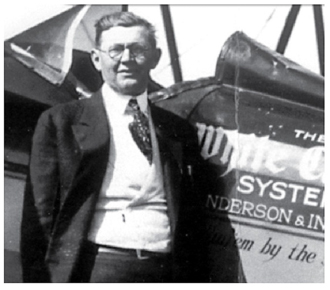 The modern hamburger, as we enjoy it today — principally a commercial object that exists in the public sphere — was first conceived in 1916 in Wichita, KS when line cook Walter A. Anderson combined a beef patty with a custom made bun designed to encapsulate it. This seemingly obvious pairing may indeed have happened at numerous points prior to this moment in domestic kitchens, commercial restaurants, or state fairs, but this occurred in isolation. The standardization required to lay the foundation for a defined, universally recognizable dish was entirely missing.
The modern hamburger, as we enjoy it today — principally a commercial object that exists in the public sphere — was first conceived in 1916 in Wichita, KS when line cook Walter A. Anderson combined a beef patty with a custom made bun designed to encapsulate it. This seemingly obvious pairing may indeed have happened at numerous points prior to this moment in domestic kitchens, commercial restaurants, or state fairs, but this occurred in isolation. The standardization required to lay the foundation for a defined, universally recognizable dish was entirely missing.
Big H Small h
For this reason, Anderson's creation did not become the hamburger until 1921. Prior to this, it was just another type of sandwich. For the hamburger to become more than a curiosity, for it to become as close to a national dish as America has, it needed to become commoditized and rationalized. This was accomplished when Anderson partnered with Edgar Waldo "Billy" A. Ingram and founded White Castle. In addition to creating the modern hamburger, White Castle also set up the first fast food "system," creating the blueprint for all fast food chains to come. The hamburger existed on restaurant menus before White Castle, but it was listed within the sandwich section. After White Castle, the hamburger became separate and distinct from other sandwiches, with its own section on the menu. The first hamburgers were small in size — about two to three ounces of beef. They became known as sliders.
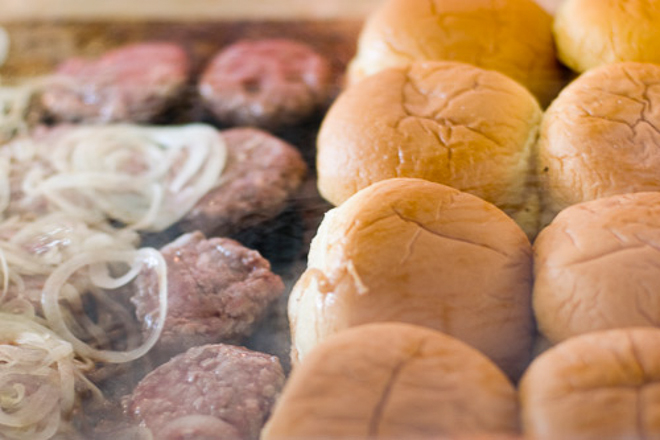
Sliders on a griddle.
For the hamburger to become more than a curiosity, for it to become as close to a National dish as America has, it needed to become commoditized and rationalized
The slider and its variant, the smashed burger, were the dominant forms of hamburger sold in the inter-war years. White Castle proliferated, and inspired a legion of imitators. Suddenly hamburger stands selling sliders dotted the American landscape, with derivative names that included the word "white" associated with some sort of brick structure — Tower, Clock, Fortress, Turret, etc. It should be noted that White Castle, which is still in business today, adopted frozen beef long ago, making the traditional method of slider preparation impossible — you can't press a frozen patty. But you can still find places using the original method of slider production, most notably in Detroit, MI and Northern New Jersey. The industrial nature of these locales is not insignificant. Sliders were by and large food for the working man, and slider restaurants tended to be found near factories and industrial parks, and on the wrong side of the tracks.
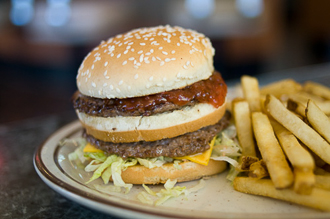 But just like America during this period, the hamburger did not remain stagnant. Innovations came quick and fast. The first cheeseburger was reputedly created in 1926 at the Rite Spot in Pasadena, CA — it was listed on the menu as a "cheese hamburger." There are, of course, numerous other claimants to the title. Bob's Big Boy in Burbank, CA is credited with creating the first double burger using a triple split bun in 1937. This is the sandwich that the McDonald's Big Mac is patterned on. But the architecture of the slider has not changed or evolved significantly over the decades, and thus it stands as a historical document, reflecting the hamburger as it existed in the pre-war years.
But just like America during this period, the hamburger did not remain stagnant. Innovations came quick and fast. The first cheeseburger was reputedly created in 1926 at the Rite Spot in Pasadena, CA — it was listed on the menu as a "cheese hamburger." There are, of course, numerous other claimants to the title. Bob's Big Boy in Burbank, CA is credited with creating the first double burger using a triple split bun in 1937. This is the sandwich that the McDonald's Big Mac is patterned on. But the architecture of the slider has not changed or evolved significantly over the decades, and thus it stands as a historical document, reflecting the hamburger as it existed in the pre-war years.
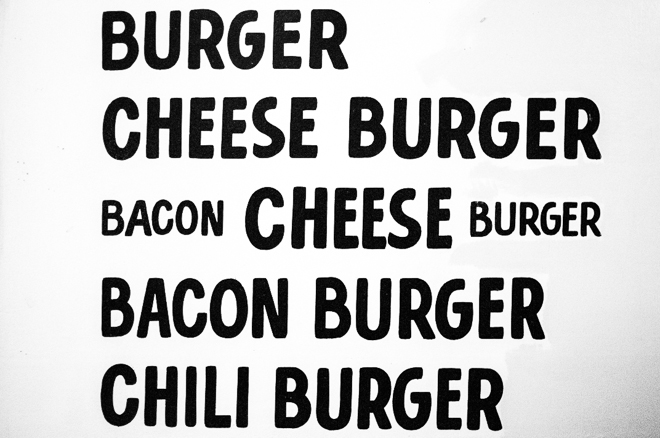
In the post World War II era, the nation enjoyed an explosion of cheap beef and cheap steel, as well as a burgeoning interstate highway system. This allowed the hamburger to move out of the industrial park and onto Main Street. Just as the slider reflected the austerity of the Depression and the inter-war years, the hamburger that emerged after the war spoke to America's rapid rise — hamburgers became bigger and more diverse.
The Hamburger in NYC
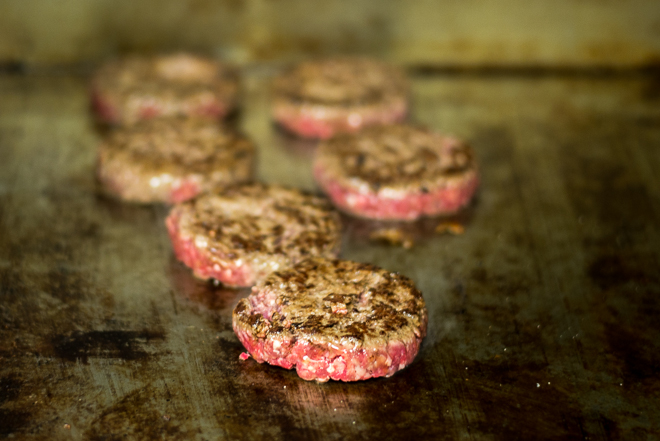
Burgers on the griddle at P.J Clarke's.
The hamburger developed somewhat differently in NYC. Because the city was largely unaffected by the interstate highway system, the drive-in was far less pertinent. And NYC already had its own established portable street foods in the form of pizza and hot dogs. White Castle opened 12 locations in the NYC metro area in 1930, but McDonald's, which emerged as the largest burger chain in the post-war era, didn't open in NYC until 1973, almost 20 years after it started franchising. McDonald's was closely followed by Burger King and Wendy's, bringing the burger wars that had been raging across suburbia to the city. The immediate effect was to put small, local burger concerns, such as the once popular chain Wetson's (1959-1975), out of business. But at the same time, it didn't stymie the development of hamburgers in the diners, restaurants, and bars of NYC.
City Dressed Beef

NYC, with its long tradition of steakhouses, fine dining restaurants, and hotels has always received the lion's share of the nation's prime beef. That was true in the 1930s when Hamburg Heaven opened selling only prime beef hamburgers. It was true in the 1950s when '21' Club debuted the first gourmet hamburger, and it is true today, when dry-aged beef and all sorts of custom blends are to be found in the hamburgers of NYC. While there are numerous hamburger styles in NYC, the most defining feature is the quality of the beef used.
Here is a look at the different styles of hamburger that you can find in NYC:
Sliders

Classic sliders from White Mana, Hackensack, NJ.
At one time, all hamburgers were sliders. This is the most elemental and diminutive form of burger. Sliders are defined not just by the size of the patty, but also by the cooking method. The beef is pressed onto a hot griddle and topped with onions until one side is cooked, and then flipped so that the onions end up on the bottom. At this stage, both halves of a split hamburger bun are placed atop the burger. The juice from the beef and the onions effectively steams the ingredients as it hits the griddle surface and evaporates, cooking the patty through and causing the bread to become soft. The process is called steam-griddling. Cheese, most commonly American, is a staple of most sliders these days, but it was not part of the original White Castle hamburger.
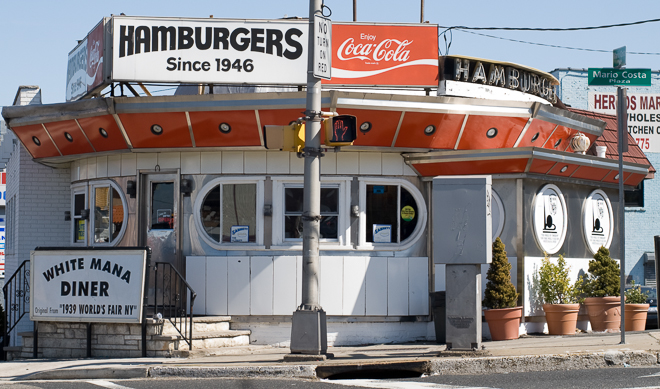
White Mana, Jersey City, NJ.
No traditional slider restaurant has survived for any significant period of time in NYC unless you count White Mana. (It was known as White Manna until it lost an N when a sign painter made a mistake.) White Mana started off as a slider kiosk at the 1939 World's Fair in Flushing, Queens, but it was then moved — lock, stock, and griddle — to its current home of Jersey City, NJ in 1946. White Castle operates several stores in the city but, as previously noted, it no longer follows the method of production that it pioneered. Sassy's Sliders opened in the East Village in the mid-1990s, eventually moving to Harlem before shuttering in 2009. The restaurant initially sold a credible version of the White Castle slider, but standards went south when it moved north.
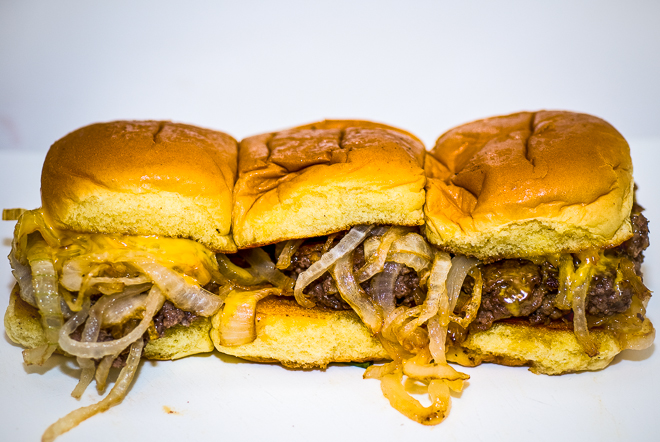
Sliders from Shopsin's General Store.
These days, there are some very good sliders indeed being sold in NYC. Shopsin's General Store in the Essex Street Market sells a rousing rendition of the form, inspired by White Manna in Hackensack, NJ, one of the nation's most iconic hamburger stands (not to be confused with Jersey City's White Mana). Mark on St. Marks Place is similarly inspired and goes a step further by grinding fresh beef in-house. Both Shopsin's and Mark use potato buns, but for a more traditional bun, a simulacrum of the White Castle bun in fact — which is especially spongy and porous with a glossy sheen on the top — head to Bill's Bar & Burger.
Mini Burgers
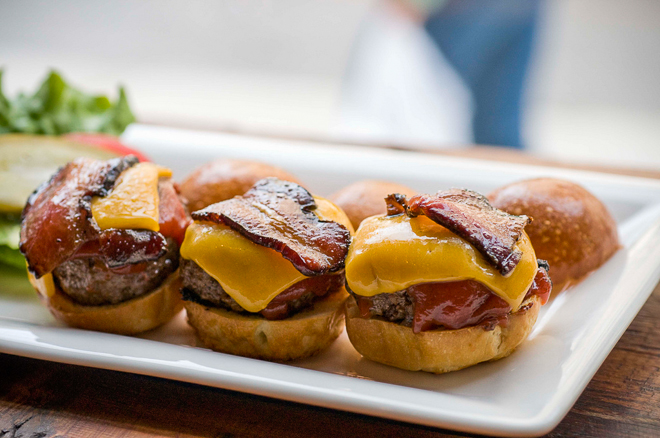
Mini burgers from Spitzer's Corner.
The word slider has been diluted to the point where almost any small sandwich of any type is called a slider. This is unfortunate. The original slider preparation represents a historically and culturally significant culinary milestone — it should be preserved with the same way that the VPN protects Neapolitan pizza. Most "sliders" that you will encounter on menus around town are not sliders at all, but just mini hamburgers. They are not steam-griddled in the traditional manner, but rather are prepared much like big burgers. This is often their downfall — steam-griddling burgers is a good way of retaining moisture. Cooking small burger in the same way that you cook a large one most often results in an arid and generally mediocre product. Mini burgers are to be found all over the place, including Pop Burger, P.J. Clarke's, Puck Fair, and Spitzer's Corner.
Smashed Burgers

A classic smashed burger from Carl's Drive In, St. Louis, MO.
Closely related to the slider, the smashed or pressed hamburger uses the essential principles of slider preparation but on larger three to five ounce patties. The beef is pressed down, often until almost paper-thin, requiring a sharp spatula or dedicated scraping implement to remove it from the griddle. Note that pressing uncooked beef, which still has solid fat, is not the same as pressing a patty that has already warmed through. Doing the latter causes the liquified fat, and thus the juiciness and flavor of the beef, to be lost to the ether.
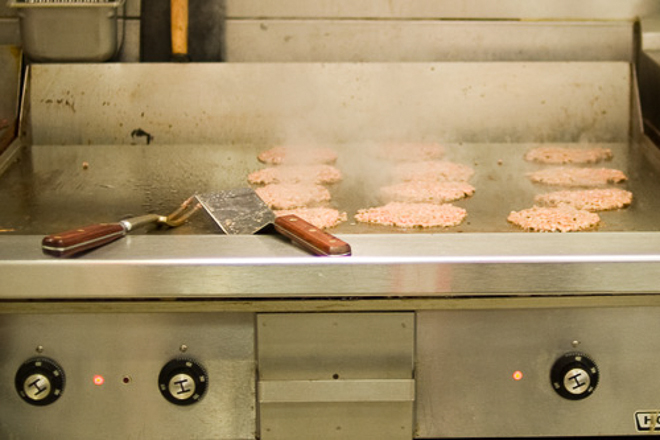
Smashed burgers on the griddle.
Because onions are not generally added, and due to the larger surface areas of the patties, this method of cooking does not produce the same steaming effect as it does with sliders. But it does create far more of the Maillard reaction — the process which turns meat brown — forming a dark bronze colored crust that is supremely crunchy.
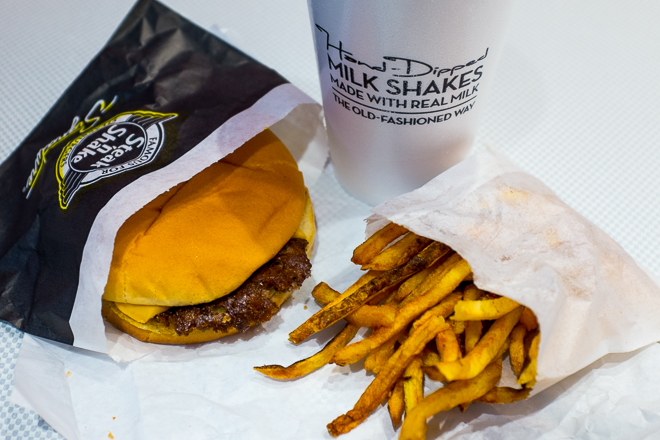
Steak 'n Shake.
Steak 'n Shake, a regional chain operating in 22 states that dates back to 1932, was one of the pioneers of the form. The method of preparation is especially popular across the Midwest. The process has gained considerable currency in NYC starting with Shake Shack a decade ago and more recently at Bill's Bar & Burger. Both the aforementioned Steak 'n Shake and the Smashburger chains, both of which employ the technique, now operate stores in NYC.
Diner Burgers
A diner without a hamburger on the menu isn't a diner at all. Outside of the dedicated hamburger restaurant, there is no menu on which a dish is more ubiquitous than that of the local diner. Diner burgers are never elaborate, boutique affairs, but they are often superb. In fact, some are so good that they make more expensive, rococo constructions completely superfluous. Diner burgers are most often offered à la carte or "deluxe" — served with French fries, lettuce, and tomato, with coleslaw and a pickle being popular additions. In NYC there are three principle forms of the diner hamburger:
The Hamburger Diner
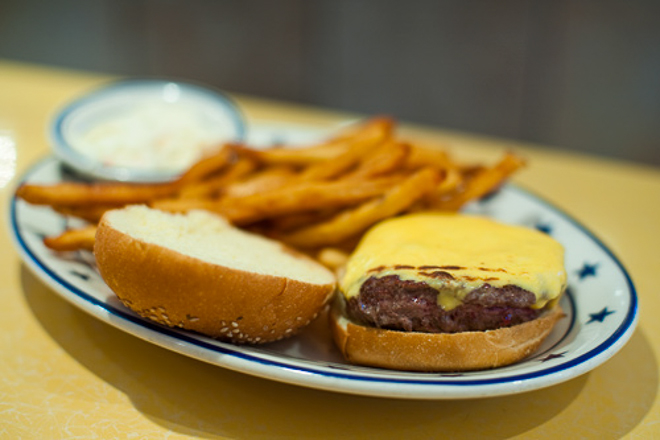
Burger Heaven.
Starting in the late 1930s, there was an emergence in NYC of a specific type of restaurant that specialized in hamburgers but also sold more traditional diner fare and offered table service. The burgers tended to be broiled and made of higher quality beef than those sold at the average slider emporium. Prime Burger, originally called Hamburg Heaven, was one of these restaurants. It opened in 1938 and closed in 2012. Hamburger Heaven, immortalized in Truman Capote's Breakfast at Tiffany's, was founded in 1943 but is now also defunct. The only remaining example of this type of burger — arguably the closest thing NYC has to an original style — is the Burger Heaven chain, which currently has three restaurants in Manhattan. Originally opened as The Beefburger in the 1940s, the name was changed to Burger Heaven in 1974. It's still family operated to this day.
The Local Diner
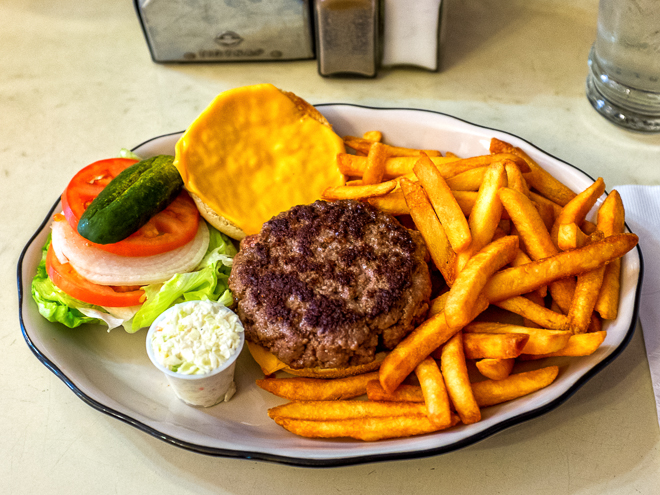
Joe Jr.
Just as a diner without a burger isn't a diner, a neighborhood without a diner isn't a neighborhood at all. Hamburgers at local diners tend to be either grilled or most commonly griddle cooked, rather than broiled, as in the case of the hamburger diners. The local diner is one of the few unitary institutions in contemporary America. Since every neighborhood in the city has a diner, paraphrasing Calvin Trillin should help you choose one: Anyone who doesn't think their local diner is best in the world is a sissy.
(With that said, Joe Jr. serves the best diner hamburger in the city.)
The "Metal Dome" Burger
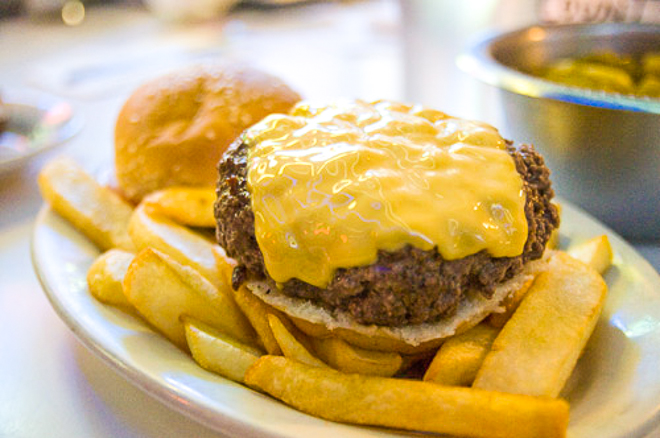
Paul's Da Burger Joint.
This type of burger is a subset of the diner hamburger and is a form that is now in decline. This style is characterized by a large griddle cooked patty that is a least an inch thick and at least seven ounces in weight (and often more). Because of the heft of the beef, the practice of placing a metal bowl or other domed object over the patty while it is on the griddle — to hasten cooking times and insure an evenly tempered product — has been widely employed.
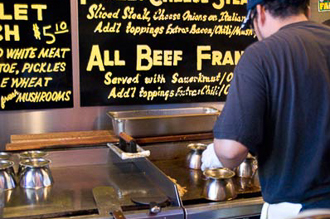 This has the added benefit of melting the cheese and warming other toppings. And toppings are almost always required here because of the sheer amount of beef. Sirloin is popular in these types of burgers, which is perceived as superior to ground chuck (the most common cut used) but is usually not. The chuck (from the front shoulder of the beef cattle) contains a lot of different muscles with varying degrees of marbling (the fat within the muscle), but sirloin tends to be far leaner and it produces a less juicy product. This style of burger was popularized at Jackson Hole Diner and Cozy Soup and Burger, both of which opened in 1972. Both are still in operation with Jackson Hole having grown to eight locations in NYC. Silver Spurs (1979) and Paul's Da Burger Joint (1989), the quirky East Village spot, also sell this type of hamburger. What the form might lack in ultimate flavor it makes up for in value for money — this type of burger typically provides very good bang for your buck.
This has the added benefit of melting the cheese and warming other toppings. And toppings are almost always required here because of the sheer amount of beef. Sirloin is popular in these types of burgers, which is perceived as superior to ground chuck (the most common cut used) but is usually not. The chuck (from the front shoulder of the beef cattle) contains a lot of different muscles with varying degrees of marbling (the fat within the muscle), but sirloin tends to be far leaner and it produces a less juicy product. This style of burger was popularized at Jackson Hole Diner and Cozy Soup and Burger, both of which opened in 1972. Both are still in operation with Jackson Hole having grown to eight locations in NYC. Silver Spurs (1979) and Paul's Da Burger Joint (1989), the quirky East Village spot, also sell this type of hamburger. What the form might lack in ultimate flavor it makes up for in value for money — this type of burger typically provides very good bang for your buck.
Hamburger Sandwich / Patty Melt
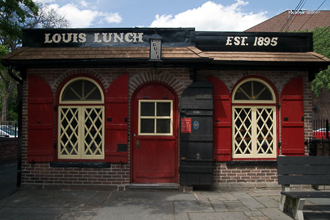 Distinct from a hamburger, a hamburger sandwich is defined by the use of sliced bread in place of a bun. Louis' Lunch in New Haven, CT is famous for serving such a sandwich continuously since 1905 (it opened in 1895). Louis' Lunch claims to have invented the hamburger, which only holds up if you accept that what the restaurant sells is in fact one. Otherwise, Louis' Lunch has yet to sell a single hamburger. As noted above, we see hamburgers on menus from the era, but listed as sandwiches. Hamburgers only gained a distinct menu section after White Castle and after the "hamburger bun" had entered the popular lexicon.
Distinct from a hamburger, a hamburger sandwich is defined by the use of sliced bread in place of a bun. Louis' Lunch in New Haven, CT is famous for serving such a sandwich continuously since 1905 (it opened in 1895). Louis' Lunch claims to have invented the hamburger, which only holds up if you accept that what the restaurant sells is in fact one. Otherwise, Louis' Lunch has yet to sell a single hamburger. As noted above, we see hamburgers on menus from the era, but listed as sandwiches. Hamburgers only gained a distinct menu section after White Castle and after the "hamburger bun" had entered the popular lexicon.
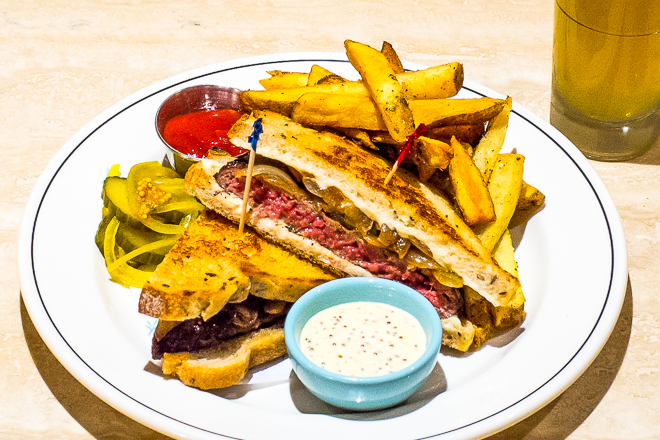
Patty melt from The Butterfly.
The specimen sold at Louis' Lunch is unique because of the specially constructed grills that hold the burger patty vertically. No one is cooking burgers this way in NYC (or the rest of the world outside Louis' Lunch for that matter) but you can find a hamburger sandwich at most diners, often called a patty melt. Pricier versions can be found at The Butterfly, St. Anselm, and Seersucker.
Bar Burgers
Along the same lines as the diner burger, at their best, bar burgers handily trounce far more expensive offerings. While the category is necessarily broad, a nuanced view reveals two distinct forms:
Tavern style
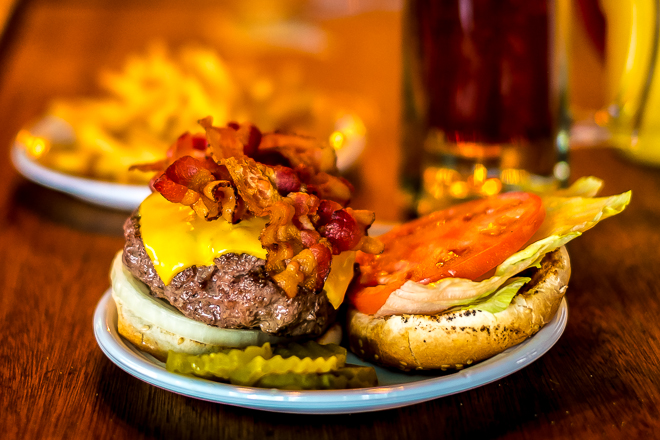
Corner Bistro.
Some of NYC's most fabled and beloved hamburgers are found in the city's taverns. While this style might lack uniformity in preparation, they tend to be to six to eight ounces in weight and served on a standard white hamburger bun, most often á la carte. Some of the city's most quintessential bars such as Corner Bistro, P.J. Clarke's, J.G. Melon, and Fanelli's Cafe fall in to this category — establishments that are uniquely New York and that couldn't exist elsewhere.
Pub Style
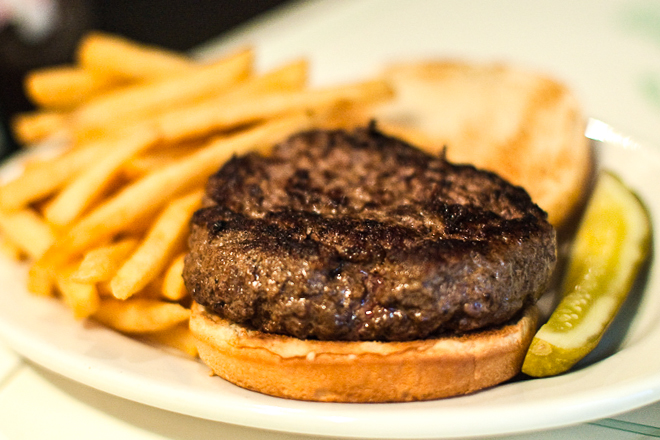
A pub style burger at Piper's Kilt.
Distinct from the tavern burger, pub style burgers are found in the Irish pubs that proliferate in NYC. They tend to be larger than the average bar burger, often weighing as much as 10 ounces, and are almost always served with French fries and often with lettuce and tomato. Prices tend to be around the $10 to $12 mark. They can be griddle cooked but are most often grilled or broiled, and the better ones are also some of the better burgers in the city. Donovan's Pub in Woodside, Queens sells a burger that is often found on top 10 lists. Similarly fine examples can be found at Molly's Pub in Gramercy and The Piper's Kilt in the Bronx.
California Style
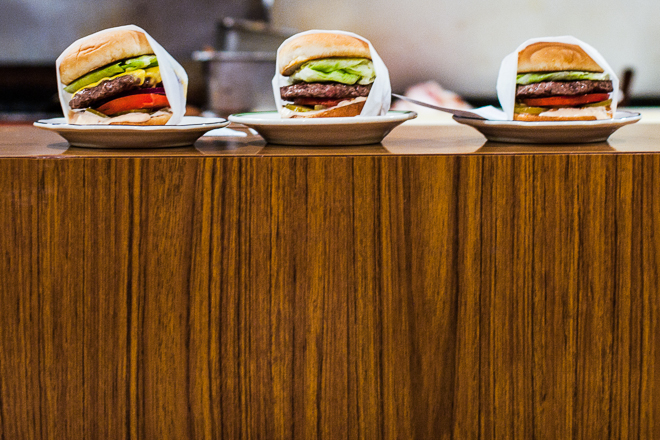
California style burgers at Pie 'n Burger, Pasadena, CA.
Broadly speaking, California style burgers use svelte patties that weigh on average three to six ounces, and they are often served as double or even triple patty stacks. They can be either griddled or grilled, and they come served on white squishy buns with reams of lettuce, tomato, raw onion, and some form of "special sauce," a variant of Thousand Island or Russian dressing.
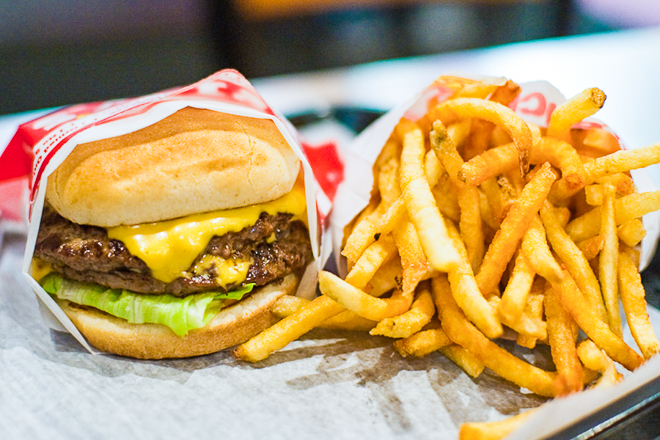
Petey's Burgers.
The California burger aesthetic is about the synergy of the ingredients
The California burger aesthetic is about the synergy of the ingredients. The thin beef patties don't work if served plain, the way a big, bawdy burger might at an NYC tavern. But suitably dressed with vibrantly colored vegetables and dripping with special sauce, the burger becomes greater than the sum of its parts. Arguably the most quintessential example of the form is In-N-Out Burger, the California based chain that has a cult like following. Blue 9 Burger, which opened well over a decade ago in the East Village, sells a burger inspired by In-N-Out, although a change in ownership has lessened the association as the menu has become diluted. Petey's in Astoria is a more faithful representation these days and both the The Counter and Fatburger, two California chains, operate outposts in NYC. McDonald's Big Mac, arguably the most iconic of all hamburgers, also originated in California. In actuality, the Big Mac is a copy of the Big Boy sandwich from Bob's Big Boy in Burbank, CA. The original Big Boy sandwich dates back to 1937 (the Big Mac was added to the McDonald's menu nationally in 1968). You can of course find Big Macs at any of the city's 240 McDonald's.
Steakhouse Burgers

Peter Luger.
Most every steakhouse serves a hamburger, but most often it is restricted to either lunch hour service or the bar menu. The steakhouses that butcher beef in-house will often use the dry aged trimmings (see below) from the steaks to fortify the hamburgers, giving them a heartier flavor. The most famous steakhouse burger is unquestionably the one at Peter Luger Steakhouse that is served at lunch only. City Hall and Porter House NY both sell commendable versions, and the one offered at Wollensky's Grill uses a mix of filet mignon trimmings, dry aged rib, and strip steak from Smith & Wollensky next door. But steakhouse burgers can just as often be overwrought affairs, with dense, unyielding buns and exorbitant price tags.
Dry Aged Burgers

Dry aged beef.
Dry aging is the process of tenderizing and enhancing the flavor of beef by letting it desiccate naturally in a controlled environment. It is a costly process as it leads to shrinkage, but the flavor is incomparable. Dry aged beef has nutty, funky, and earthy notes. Outside of the steakhouse and boutique butcher almost all beef is "wet aged" these day — it is tenderized in plastic bags, which does not enhance the flavor in the same way as dry aging.
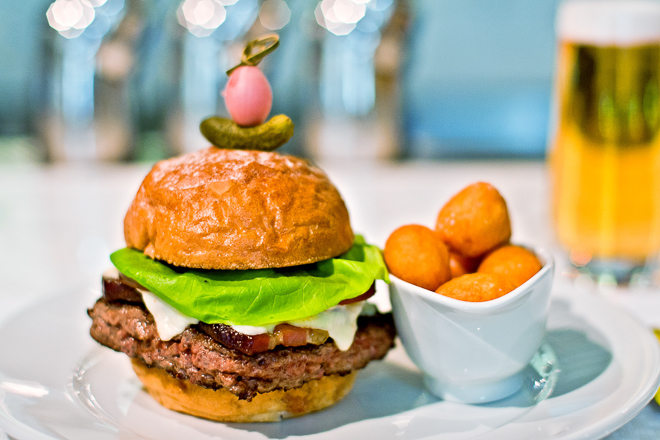
Ai Fiori White Label Burger.
NYC, by virtue of its rich culture of steakhouses, is the dry aged capital of the world. More dry aged beef is sold and consumed here than at any other place on earth, and not surprisingly, it makes its way into plenty of hamburgers. Obviously this happens in the aforementioned steakhouses, but there is also a tradition of local butchers creating custom blends using dry aged beef. Minetta Tavern, Pennsylvania 6, Jones Wood Foundry, HB Burger, The Brindle Room, Ai Fiori, and Roberta's sell hamburgers with dry aged beef, to name but a few. Even the chains are getting in on the action — BurgerFi, the burgeoning Florida based chain with a location in NYC, offers a 28 day dry aged ground brisket burger.
Chef / Luxury / Gourmet Burgers
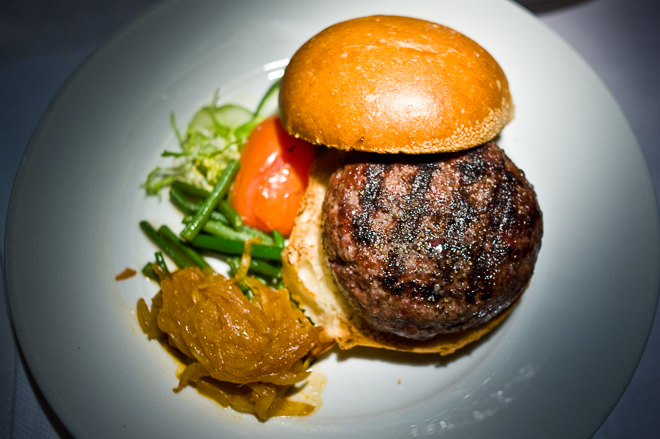
21 Club.
NYC is home to the original gourmet hamburger at '21' Club, which debuted in 1950 and was cooked in duck fat and spiked with fennel seeds. It sold for a whopping $2.75, in an era of five and ten cent hamburgers. Interestingly, that is equivalent to approximately $26.26 in dollar-adjusted value. (The current price of the burger is $34, although the preparation is different.) The most famous contemporary chef burger is most assuredly Daniel Boulud's foie gras stuffed, black truffle dusted DB Burger from db Bistro Moderne. The burger made a huge splash 13 years ago when it was unleashed and kick started the high-end burger trend that spanned the remainder of the decade. It is still available today.
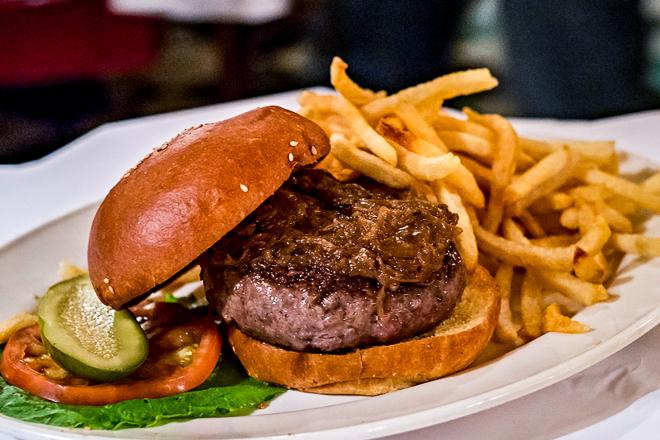
The Black Label Burger from Minetta Tavern.
This movement found high expression at Minetta Tavern, where chefs Lee Hanson and Riad Nasr crafted the "Black Label" hamburger using a dry aged blend from noted butcher Pat LaFrieda. While the DB Burger is an exercise in adding luxury ingredients to a hamburger, the Black Label is an earnest attempt at elevating the base ingredients themselves. But arguably the most celebrated hamburger of this type is April Bloomfield's masterful version at the Michelin starred Spotted Pig. In fact, it has been argued that the restaurant won that star precisely because of the burger.
Lunch Special, Late Night, and Secret Burgers.
Fine dining restaurants and establishments whose menus wouldn't be expected to serve them have taken to offering burgers at lunch or as late-night specials or even as secret menu items. Roberta's, Gramercy Tavern, and The Marrow all offer lunchtime hamburgers, and Maialino offers one on the bar menu after 10:30 p.m. nightly.
Douche Burgers
Distinct from burgers crafted by chefs and intended as menu staples, there have been numerous instances of hamburgers costing hundreds of dollars with all manner of luxury ingredients piled atop. They merit no further discussion.
The Restaurant Burger
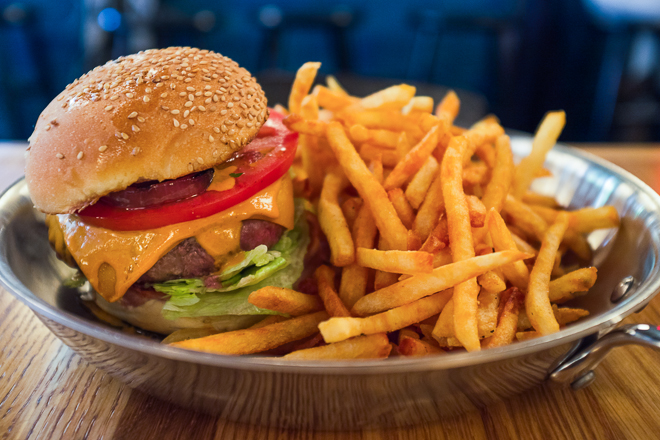
The Dutch.
This isn't a type of burger as much as a perceived obligation on the part of restaurateurs. Costing anywhere from $12 to $21, these burgers tend to be large, eight to 10 ounce affairs served with French fries, lettuce, and tomato. They are usually distinct from generic diner burger in that they will often feature exotic cheeses and fancy buns, with brioche being the most common. They can often be excellent but are rarely the principle focus of the restaurant.
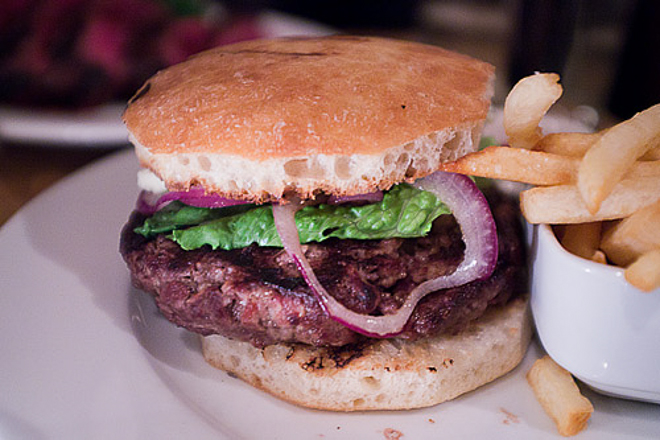
An Italian Style Burger from La Follia.
Alternatively, such burgers can reflect the cuisine of the restaurant, usually to the detriment of the finished product. An Italian restaurant might top a hamburger with gorgonzola and serve it on a focaccia bread, or a Greek establishment might serve a version with feta cheese and olives. The 5 Napkin Burger, essentially an homage to French onion soup sold at Hells Kitchen's Nice Matin, proved so popular that it fostered the 5 Napkin Burger chain, which has grown to three locations in the city, as well as outposts in Miami and Boston.
The Burger Restaurant

Umami Burger.
Building on the tradition of the hamburger diner, there are a number of restaurants that specialize in burgers, while also offering a broader menu. There is no uniform method of preparation or single style represented here, but the diversity they offer is reflective of NYC's appetite for the hamburger. The burgers at these types of places tend to be in the same price range as restaurant hamburgers, but they are usually better executed by virtue of specialization. Locally based Five Napkin Burger, Burger & Barrel, Island Burger, and Bill's Bar and Burger are good examples of the type, as are West Coast imports The Counter and Umami Burger.
Pastrami Burger
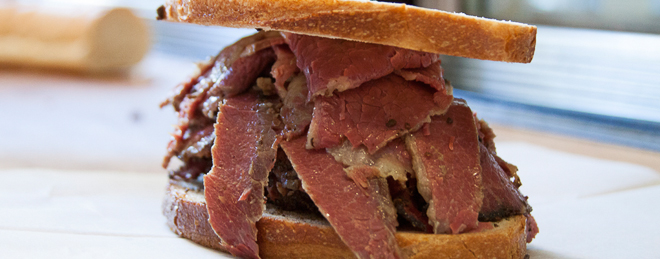
[Photo: Pastrami Queen]
For a city that boasts the world's best pastrami, NYC does not have a significant culture of topping burgers with the smoked meat. The practice has actually gained the most traction in Southern California, most famously at the Hat in Alhambra, which has been serving pastrami burgers since the 1950s. The idea spread throughout Los Angeles, with many burger stands offering the pairing. Pastrami burgers have been popular in Salt Lake City, Utah since the late 1970s, inspired by the California model. You can find pastrami topped burgers at some old school delis like Sarge's and Pastrami Queen, although the latter is just a hamburger patty stuffed into a pastrami sandwich.
Roast Beef Burger
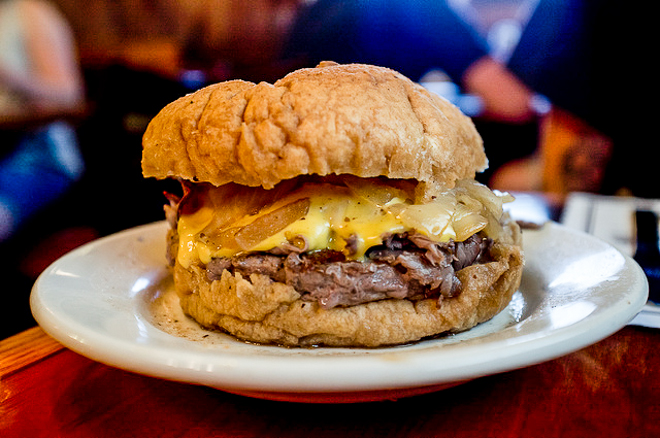
Brennan and Carr
Along the same lines as the pastrami burger, Brennan & Carr in Brooklyn sells a hamburger topped with roast beef, gravy, Cheese Whiz, and onions — a twist on the roast beef sandwich that made the Sheepshead Bay restaurant famous.
"Wagyu" or "Kobe" Burgers
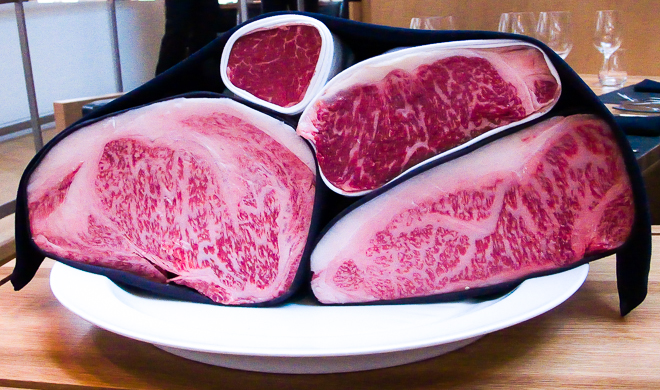
True Japanese Wagyu on the bottom, American Kobe style beef at top.
It is extremely unlikely that any of the "Kobe" or "Wagyu" burgers that appear on restaurant menus are actually made from pure Japanese beef
Let's dispel some myths here: It is extremely unlikely that any of the "Kobe" or "Wagyu" burgers that appear on restaurant menus are actually made from pure Japanese beef. Wagyu refers to any one of several Japanese breeds of cattle. Kobe is a city and the capital of the Hyōgo Prefecture in Japan. When Wagyu cattle are reared in this area under certain conditions, they attain a pedigree and legal designation, in much the same way that Champagne does in France. The best of this beef is highly marbled, ethereally tender, and hideously expensive. It is also probably some of the worst beef for burgers because the low melting point of the fat would likely cause it to liquify during grinding. What is often referred to as "American Kobe" is actually a cross breeding of Wagyu cattle with a sturdier breed such as Black Angus or Long Horn. This is done because pure Japanese Wagyu would generally not survive America's harsher climates. Because of the evocation of luxury, many places will market burgers as "Kobe," although it is rarely, if ever, true Japanese Wagyu. Even if it is, the ridiculous expense aside, there is little point. The draw of such beef is the inherent marbling it exhibits, and when you grind beef for hamburgers, you can precisely adjust the fat ratios.
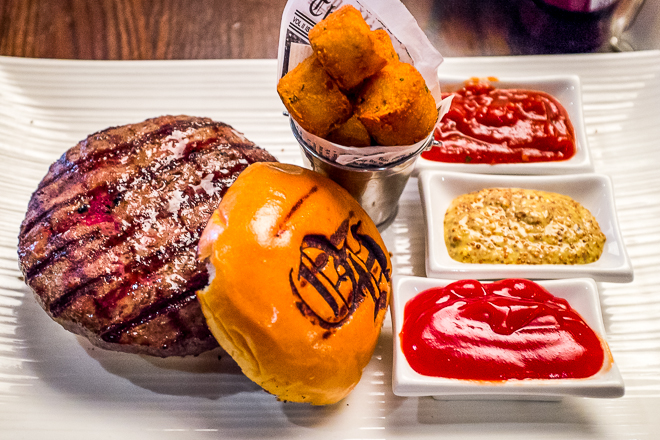
American Kobe Burger from The Old Homestead.
The Old Homestead Steakhouse, which incidentally sells true Japanese Wagyu beef steaks, uses Snake River Farms "American style Kobe Wagyu" for the $43, 20 oz "Kobe" hamburger on its menu. It is actually not so exorbitantly priced considering the heft of the patty, which is twice as large as most hamburgers. But if it was real Kobe, it would likely cost closer to $430 than $43.
Smoked / Barbecue Burgers
The process of smoking meat "low and slow" to tenderize tough cuts is the essence of barbecue and the opposite of the best way to cook hamburgers and steaks, which are better served by high and fast cooking methods. Barbecuing and hamburger cooking are as far apart as the Flintstones and The Jetsons. There have been some excellent hamburgers sold at some of Manhattan's barbecue restaurants, but they are either grilled or griddled rather than smoked. Blue Smoke in particular sells a hamburger that has been often ranked amongst the best in the city. This is perhaps not surprising because it is part of the same restaurant group as Shake Shack.
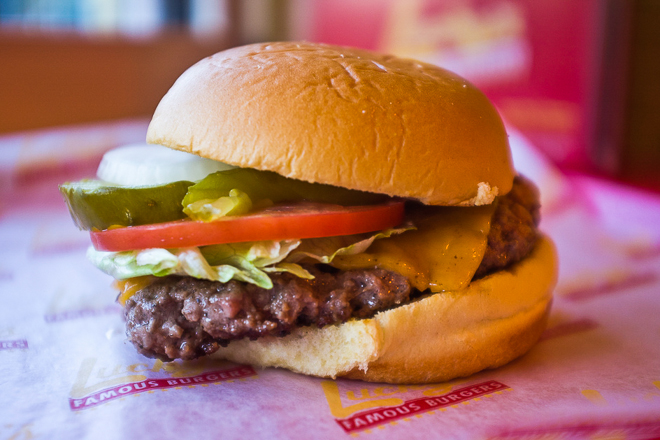
Lucky Burger.
Lucky's Famous Hamburgers, which opened on Avenue A in 2005, used to cold smoke burger patties before searing them on the griddle. The process was abandoned when the original owner sold the business around 2008.
Chili Burger
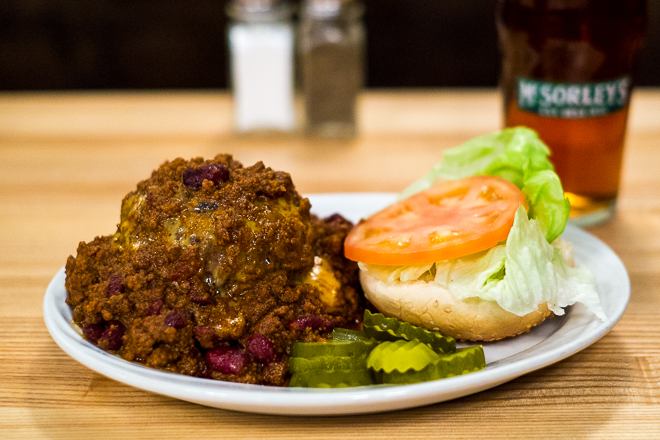
A Chili Burger from Corner Bistro.
Topping burgers with chili most probably originated at Tommy's in Los Angeles. The restaurant serves a finely minced chili atop a prototypical California style burger. You can find chili burgers on plenty of menus around town, such as Burger Heaven, Corner Bistro, all of the "metal dome" burger restaurants, and most diners. Perhaps the closest to Tommy's is the chili burger at Crif Dogs in the East Village.
Green Chile Cheeseburger

A green chile cheeseburger.
The green chile burger originated in New Mexico. It's defined by the use of the indigenous Hatch green chiles, which produce a slow, grinding heat. The Bobcat Bite, which dates back to 1947, is one of the more famous places that serves the style. Various restaurants in NYC offer homages to the style, such as Schnipper's Quality Kitchen, Clarke's Standard, and P.J Clarke's. But only Shopsin's uses genuine Hatch chiles — the others use poblano or jalapeño peppers to mimic the heat. Purists will confirm that there is no substitute for the real thing.
Juicy Lucy / Stuffed Burgers

Whitmans.
The Juicy Lucy is a specialty of Minneapolis, MN and consists of two burger patties stuffed with cheese and seared on the griddle. It originated at Matt's Bar in 1954 and proliferates in the region. Whitmans sells a variant of the Juicy Lucy, which is made by stuffing a patty with pimento cheese (see below) rather than the standard American. Less referential stuffed burgers can be found at various locations such as The 13th Step and Stumble Inn, which offers a kitchen sink's worth of possible stuffing choices.
Pimento Cheeseburger
Pimento cheese is a mixture of cheese, mayonnaise, and pimentos. Popular in the South as a sandwich filling, it is also used to top burgers.
Goober Burgers

Whitmans.
Topped with a healthy dollop of peanut butter and mayonnaise, Goober burgers originated at the now shuttered Wheel Inn Drive In in Sedalia, MO. No one is doing a completely faithful version in NYC these days, but Whitmans, apparently the repository for regional variations, offers a hamburger topped with bacon and peanut butter.
The New NY Style?

Shake Shack.
When Danny Meyer opened Shake Shack in 2004 as a seasonal, boutique burger stand, he combined disparate elements of Americana. From the Midwest, specifically Carl's Drive In in St. Louis, MO, he adopted the smashing technique popular throughout the region. The toppings — leaf lettuce, plum tomatoes, and a mayonnaise based special sauce — seem inspired by the California style. And the bun is sourced from Martin's, a Pennsylvania Dutch bakery. But it's the beef — originally ground by hand in the basement of Eleven Madison Park, Meyer's fine dining restaurant, and later by butcher Pat LaFrieda — that truly sets the burger apart. While the Shack burger might be an amalgam of different forms, it can be argued that it has emerged as a distinct NYC style. This type of burger — griddle cooked, high quality beef served on a potato bun with American cheese — can be found at numerous burger spots around town. HB Burger, Lucky's Famous, and Black Market all sell a form of this burger. Whether the style will become ubiquitous remains to be seen, but it is certainly gaining plenty of adherents.
· All Coverage of Eater Guides [ENY]